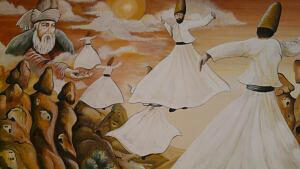JUNE 1, 2022

Sufism has often been described as the opposite of Wahhabism. While Islamic empires were created and expanded through brute force, Sufism is said to have spread Islam through love and peace. However, many historical accounts say that the Sufis ventured into only those territories where Islamic power was already established. It means that the spread of Islam by the Sufis was carried out under the shadow of emperors’ swords.
Sufism also envisages a purely racist spiritual regimen where the highest office, as well as most administrative positions, are reserved for a particular race/caste. We must see the history of Sufism to explore the facets that hitherto remain in the dark.
Birth of Sufism
The story begins with Uthman Ibn ʿAffan, the third Caliph (khalifa) of the Arabs, and the allegations he faced. One of the many grievances that the public raised was that he gave preference to his fellow brethren (Banu Umayyad) in the administration. A revolt soon followed and he was murdered. Under these circumstances, Ali Ibn Abi Talib was appointed as the new Caliph. But the governor of Syria, Mu’awiya I, who belonged to the Banu Umayyad tribe, rebelled against the central authority (the Caliphate) saying that he had an Islamic right (qisas) to avenge the murder of his tribe member Uthman, and, until his killers were handed over, would not concede to bait (bayʿah)—declare allegiance—to the newly appointed Caliph.
Taking cognisance of this open challenge to his authority, the newly appointed Caliph Ali declared Mu’awiya a rebel and personally initiated military action against him. But even after marching against Mu’awiya several times during his reign, he could never succeed. Thus, two parallel Islamic regimes continued to function, and both were led by two sub-castes of the Quraysh tribe.
After Ali, his eldest son Hasan (who was born from Fatima) was appointed Caliph. But he chose to sign a treaty with Mu’awiya and handed over the Caliphate to him. When the Caliphate went to another sub-caste of the Quraysh — the Banu Umayyads — some people rebelled against them, saying that the Banu Hashim tribe (Sayyid caste) was the real claimant to the rights of the Caliphate. They asserted that it should remain in the lineage of Muhammad’s daughter Fatima and Ali (Muhammad’s cousin who later became his son-in-law) because it was closer to the lineage of Muhammad.
After this, the rebels started the fight to reclaim the Caliphate, supported by another sub-caste of the Quraysh named Banu Abbas. The Banu Abbas tribe (Abbasids) succeeded in reclaiming the Caliphate. During the rule of the Abbasids, several people from the Sayyid caste chose the path of revolt against the Caliphate, saying that since they were the children of Ali-Fatima—‘the real family of Muhammad’—they had a natural right over the Caliphate. However, they could never be completely successful.
Since the Sayyid caste could not achieve physical authority (Caliphate), it led to the foundation of the concept of ‘spiritual authority’—referred to as the Sufi tradition. Many anecdotal stories were created to establish the Sufi tradition as an integral part of Islam. They have become so famous over time that now they seem to be perceived as the truth.
Hierarchy of spirituality
Under the Sufi traditions, the concept of ‘spiritual positions’ and their scope of operation (jurisdiction) have also been propounded for the functioning of the system. The position of Sufi/Wali can be assumed only by those whose lineage comes from Muhammad’s grandsons (daughter’s sons) Hasan-Husain and then ultimately again merges with Mohammad’s lineage through Ali-Fatima. Among these, the Ghawth (‘the help’) is the supreme position. Under him come the Qutbs (‘axis, pole’). However, in some places, Ghawths and Qutbs are considered equals. Then come the three Niqbas/Nuqabas (‘leaders’). Then the five Amnas. They are followed by seven Awtad or Abrar (‘stakes’ or ‘props’ of faith). Then come 40 Abdals (‘substitutes’). Lastly, there are 300 Akhyars.
Everyone’s jurisdiction, authority, and power were different in the order and no one is allowed to encroach on others’ territory. After the demise of an Auliya/Wali/Sufi of the upper rank, a Sufi from the lower rank gets promoted and the subsequent vacancies are filled thus.
Apart from being a Sayyid, there are other essential conditions that Sufism hinges on. For example, a Wali/Sufi/Pir (with a couple of exceptions) must be a male. The Ghawths, Qutbs, Abdals, etc. would have to live in secrecy and the common people could know which Wali/Sufi was ranked as Ghawth, Qutb or Abdal. Only the revered Sufis/Walis could know their address and who the dictator (kshtrap) of a particular region is. Often only after the death of a top-ranked Sufi, it could be revealed what rank he was.
From America to India, those who follow the Sufi tradition believe that it is these Ghawths, Qutbs, Abdals, etc., who run the nizam (system) of the entire world, that they are the true representatives of God.
Several anecdotal stories can be found in the annals of Sufism. One of them tells the tale of a king traveling from Punjab to Delhi, who goes to seek permission and blessing from the Wali before embarking on the journey. The Wali allows him to leave with a blessing but says that when he reaches a certain place, he should again take permission and blessing from another Wali because his jurisdiction ends there. His blessings would only work within his territory.
Sufi traditions and Sayyidism
In the Sufi tradition, there is also a process of giving khilafat (leadership), under which a Caliph bestows rights to one of his murids (disciples) for giving out baits who are later called the Caliph, Pir or Murshad of that Sufi tradition. Here too, the famous book of Hadith (based on Muhammad’s deeds and preaching) written by scholar Muhammad al-Bukhari has a reference to Hadith “Al-Aimtu Main al-Quraysh”, that is, a leader (Amir, Caliph) from Quraysh (Sayyid, Sheikh) community. Even among the Sayyids, Fatimi Sayyids are preferred for the khilafat. This tradition continues to this day.
The place where the tomb of a Sufi or Pir is situated is called dargah/darbar—royal court. Sufis or Pirs also add Shah (which means the king) as a prefix or suffix to their name. Their murids (disciples) refer to them as sarkar (master). They can be heard saying, “sarkar ka yeh huqm hai, sarkar aane wale hain, sarkaar ke huzur mein pesh hona hai…” (Master has ordered this, the master is on his way, we are present in the company of master…)
From anecdotes to hierarchy, the Sufi traditions lend themselves toward a kind of indirect determination of authority. In a way, Sufis or Pirs used to run a parallel system and often worked to get the man of their choice into the government and also succeeded in installing their choice as the badshah. At one point in time, and in some places even today, their position is like that of a medieval pope. Even today Ashraf Sufis, Walis and Ulemas interfere in the administration by establishing a proximity with the government of the day.
In all its essence, the Sufi tradition is just an enabler of Sayyidism.
Written by Faiyaz Ahmad Fyzie. He is a author, translator, columnist, media panelist, social activist, and medical doctor by profession. Views are personal.

































































































